Sun bore down on the Uyxat Powwow Grounds on a Monday in late June.
The smell of seafood chowder and the sounds of drumming drifted from Achfa-Hammi, the plankhouse up the hill. The powwow arbor threw a near-perfect circular shadow onto the turf in its center. Between the two structures, a small village formed with tipis, tents and a game of tackle football.
Nearly 300 children had come from around the world to the powwow grounds in Grand Ronde, Oregon, west of Salem for the latest rendition of Wellness Warrior Camp.
Emerging science links historical trauma to present and future health outcomes. It's theorized that trauma associated with atrocities committed against Indigenous peoples throughout history has been passed down from generation to generation, often manifesting in unhealthy relationships, substance abuse, post-traumatic stress disorder and suicide.
The four-day gathering in Grand Ronde aims to show the youngest generations of Indigenous people the power of connections — to earth, to identity, to culture and to each other — in healing the pain they carry.
“When we think of historical trauma, we think of how the colonization is so much about ‘disconnecting from,’” said Cristina Lara, who works for the youth prevention program with the Confederated Tribes of Grand Ronde. That’s disconnection from land, languages, foods, ceremonies, games, stories — disconnection from culture and identity.

Left: Children sit in the powwow arbor while awaiting the start of Wellness Warrior Camp. Right: Jordan Cocker offers thanks to the Confederated Tribes of Grand Ronde for hosting the camp at their powwow grounds.
Bradley W. Parks / OPB
Warrior Camp, put on by the Gresham-based Native Wellness Institute (NWI), creates an environment to deepen, and in some cases reestablish, those cultural connections.
Children play traditional games and take part in ceremony. They eat only first foods like salmon and deer at the camp and often introduce themselves in Native languages. The goal is for children to walk away from Grand Ronde with a wellness toolkit of sorts to deploy within themselves and their communities.
"They get to learn it in their head and they get to feel it in their heart," NWI executive director Jillene Joseph (Gros Ventre) said.
The camp preserves and evolves traditions while modeling balanced, healthy lifestyles for Native children who may not have similar circumstances at home.
“When we think of what our communities might have looked like, everybody’s got a role, everybody’s doing something, everybody’s in the kitchen or part of making this happen and kids grow up in a place where they know what that looks like,” Lara said. “And they get to decide what that looks like for them.”
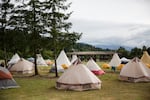
The powwow arbor sits beyond a small village of tipis and tents at Wellness Warrior Camp.
Bradley W. Parks / OPB
Making that environment the norm requires practice and participation across generations, Lara said. Establishing the cycle of intergenerational trauma took repetition, so ending it, too, will require repetition.
Warrior Camp is one place where that work is happening.
These four stories from the 2019 camp spotlight people leading the cultural shift to instill healing across generations.
Click a title to jump to a section or just read straight through.
THE CAMPER | THE NEW LEADER | THE PROFESSIONAL | THE ELDER

THE CAMPER: MARIAH BENITEZ
Dusty haze caught the last remaining light beaming into Achfa-Hammi. Mariah Benitez, 15, was rushing to get ready in a small dressing room near the plankhouse entry.
Her friend braided Mariah’s hair and helped put on her makeup by iPhone light — two circles under her eyes and three stripes down her chin. Mariah (Siletz) pulled on a skullcap and draped herself in a shelled skirt and a pile of necklaces.
Thursday was cultural sharing night at Wellness Warrior Camp, where tribal delegations perform for the entire village.

Members of the Walker River Paiute Tribe lead campers in a dance on cultural sharing night at Wellness Warrior Camp in Grand Ronde on Wednesday, June 26, 2019.
Bradley W. Parks / OPB
This was Mariah’s first year at the camp. She and some of the other Siletz attendees had prepared a series of songs and dances — things she hadn’t before considered as acts of healing.
“My expectations were, like, running,” she said, laughing.
That was true of the camp in the past. The camp was once focused on movement and restoring physical health to tribal youth. Before that it was a culture camp, before that a leadership camp. Now, Wellness Warrior Camp has grown to roll all of those versions of itself into one. The goal is to help individuals find balance in mental, emotional, spiritual and physical health.
“Connection” is a critical word in the camp lexicon. Between ceremonies and meals, children rotate between different cultural activities. The camp schedule phrases those rotations in terms of the connections built: connecting to horses, connecting to Native movement, connecting to the power of letting go.
Connection could be as simple as physical contact, but it often runs deeper.
“We have connections with the world and not just people,” Mariah said. “And we can partake in that in our lives.”
Mariah is a busy person.
She’s a student at McNary High School in Salem and was recently elected to student government. She’s also in her third year on the Youth Council for the Confederated Tribes of Siletz Indians, now serving as treasurer. Mariah keeps a full calendar of camps and had just two weeks off this summer.
All of those commitments can pull her out of balance.
“I have a lot of anxiety and stress on me because I’m really busy, which doesn’t hold me down,” she said, “but it does have, like, a part in when I’m mad or sad.”
Wellness Warrior Camp, she said, helped her realize that “a day without your phone or a day without another world” is better spent connecting to the world under her feet.
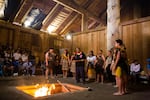
Māori visitors from New Zealand perform to open cultural sharing night at Wellness Warrior Camp.
Bradley W. Parks / OPB
Mariah pressed her feet firmly against the ashen floor of the plankhouse to carry the weight of the shells she wore.
“When I feel the most well is when I’m with my family, when I’m dancing Nee Dosh, or powwow dancing for our tribe,” she said. “… I just feel like that really just makes me remember I’m from a special, unique place.”
The Maori group finished their performance and the Siletz were called to the floor.

THE NEW LEADER: KOBE NORCROSS
Campers and chaperones trickled into the bleachers encircling the powwow arbor as the clock neared 3 p.m. for their welcome to camp.
Kobe Norcross, 17, stood in the center of the turf watching people take their seats. Standing with him were the other camp leaders, most in their 20s, wearing bright blue shirts stamped with a bison and the words “WELLNESS WARRIOR” on the front.
The camp creates an environment for kids to escape their comfort zones through cultural exchange and “healthy risks.” Youth leaders split the campers into clans with children from various tribes; Kobe took charge of a clan this year.

Campers split up into clans with people from various tribes to create a baseline for cultural exchange.
Bradley W. Parks / OPB
For some children, a “healthy risk” may be making a new friend from another tribe. For others, it might be talking to someone about problems at home or in their communities.
“A lot of communities don’t have that environment and they don’t have access to it,” Kobe said. “If they did have access to it, [and] it’s definitely a positive place for them, they’d probably end up being there a lot.”
Youth leaders want Warrior Camp to be that positive place.
This was Kobe’s third year at the camp, his first as a youth leader.
“My first time [as a camper] I was actually really introverted,” he said. “This was, like, before I started becoming sociable.”
Kobe (Ojibwe, Grand Ronde, Sioux-Assiniboine) struggled to build relationships when he was younger. He’s moved around a lot — from Portland, to Montana, to Kansas, back to Portland, to South Dakota, to Phoenix, to Northern Arizona and now back to Portland again.
“I couldn’t connect with other people,” he said. “I didn’t know how to.”
Kobe first came to Wellness Warrior Camp when it was held at Lewis & Clark College in Portland. Campers stayed in dorms and ate cafeteria food, he said. Kobe, as his first name might suggest, spent a lot of time in the gym playing basketball.
The camp incorporated more traditional games when it moved to Grand Ronde a few years ago, featuring sports like doubleball — a game similar to lacrosse played with sticks and (formerly) bull testicles.
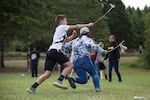
A girl runs for the goal during a game of doubleball at Wellness Warrior Camp.
Bradley W. Parks / OPB
Sports and ice breakers allowed Kobe to “get out of my little social bubble and make new friends.”
“This camp is designed to push out youth leadership,” he said. “So they can bring back these foods and these games — just what they learned — back to their communities.”
After opening remarks, Kobe and the other camp leaders took turns introducing themselves to the village — often doing so in their Native tongues first, that itself an act of healing.
The camp leaders finished and sat down on the turf, inviting children and adults to take their first healthy risk of the week. And one by one, they introduced themselves to the crowd.

THE PROFESSIONAL: CRISTINA LARA
Wind threatened to blow a rainstorm over the Uyxat Powwow Grounds, but the clouds mostly just spat a few droplets.
Cristina Lara, 35, had been helping to prepare dinner behind Achfa-Hammi as campers started to make their way up the hill. Children moved efficiently through the food line. Clutching plates, some took seats amongst the tall trees surrounding the plankhouse. The air was heavy with the smell of campfire smoke.
To Lara (Chinook, Shoshone, Grand Ronde, Mexican), this scene came close to fulfilling an ideal.
“Healing is when we’ve provided a space or opportunity for people of all ages to sit with themselves and learn about that [trauma] and let go of that,” Lara said.
And those are two of the major goals of Wellness Warrior Camp: to identify the sources of pain or stress, and to model different ways of living for Native youth who may come from much harder circumstances.

Wellness Warrior Camp allows children like Mariah Benitez, 15, right, to help with meal prep in the traditional kitchen outside Achfa-Hammi. The camp serves only first foods like salmon and deer.
Bradley W. Parks / OPB
Lara works in the youth prevention program for the Confederated Tribes of Grand Ronde. The program provides services and resources aimed at controlling, reducing and preventing ills like juvenile crime, substance abuse and suicide, which disproportionately affect Native populations.
Traumas such as those can “take over,” Lara said, and become a norm for any given person, family or community — particularly those afflicted by poverty or other harsh living conditions. When that happens, “it’s always crisis after crisis,” Lara said. “Families sort of live moment to moment in survival.”
Thus, a cycle is created. To break that cycle, norms must change. For norms to change, Lara said, children need to know they have other options to live healthier lives.
Wellness Warrior Camp finds those options in the foods, the landscapes, the languages and the ceremonies Native peoples have known for thousands of years.
The theory is that disconnecting from that historical wisdom has led to the proliferation of crises in Native communities and that reconnecting to that wisdom brings healing. The foods and activities the camp presents to children are not new — in fact, they’re very old. But the packaging of summer camp makes them more accessible to children today.
“I think that’s empowering in this day and age for young people to be like, ‘I could do that and it feels good and it’s scary,’” Lara said, “‘but it feels good and I want to keep doing that.’”
The Grand Ronde tribes have worked with Native Wellness Institute to center concepts of healing with other subgroups within their community, including tribal staff. Lara said, over the years, she's come to better understand the importance of culture to healing work.

Rob Johnston speaks to the campers before a medicine tie ceremony at the start of Wellness Warrior Camp as light beams into the plankhouse.
Bradley W. Parks / OPB
The Confederated Tribes of Grand Ronde saw the bottom of the cultural well when the U.S. government terminated them in 1954.
Since then, though, the tribes have embarked on cultural restoration efforts that led to their federal reinstatement, the proliferation of languages and craftwork, and even construction of the Uyxat Powwow Grounds themselves.
The arbor and the plankhouse symbolize the resilience of the Grand Ronde tribes, the power of culture in healing centuries-old wounds, and the reclamation of the Native identity the U.S. government tried to take from them many decades ago.
Lara looks at the plankhouse, Achfa-Hammi, and hopes that campers can look at it in the same way, like “this plankhouse belongs to them and they belong to the plankhouse.”
“I think the most important thing is it’s hard for people, anybody who’s experienced hurt, especially from other people, to ask for help and to remember that we’re connected in all different ways,” she said.
“And I think that that’s one of the most important things is to remember ... when I’m here, or I’m singing this song, or I’m praying this way, or I’m laughing with someone, that nobody can take that from me and I belong to those things, or to this place, to those stories.”

THE ELDER: JOHN SPENCE
Koda’s eyes and ears started to droop standing in the warm morning sun. About a dozen campers surrounded the 7-year-old quarter horse, stroking his sides and scratching his face. One child leaned his head against Koda’s neck, cradling the horse with his arm.
Koda’s owner, John Spence, could tell by looking at him that this was a happy horse.
“This was the most [people] we had around him,” Spence said, the admiration showing in his voice. “And that little horse just stood there and he practically fell asleep.”
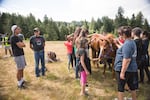
Kobe Norcross, 17, left, talks to John Spence while campers pet and brush Spence's horse, Koda, at Wellness Warrior Camp in Grand Ronde, Ore., Wednesday, June 26, 2019. Spence is trained in equine therapy and leads the connection to horses station at the camp.
Bradley W. Parks / OPB
Spence had seen people connect with Koda before — but not like this. As Koda’s eyes softened, the horse lifted one of his back legs just a few inches off the ground. It was one of those involuntary movements that signaled complete and utter relaxation, like when you find a dog’s tickle spot.
“I couldn’t believe it,” Spence said. “Especially with all those kids around. And so I didn’t even worry about his anxiety.”
In recent years, Spence has come from his home in Beaverton to Grand Ronde, where he keeps Koda, to facilitate equine therapy at Wellness Warrior Camp.
Being around the campers reminds him of his childhood and how he grappled with his own identity. His mother died when he was 3 and he never met his biological father. He and his sisters ended up in foster care. Spence faced racism growing up in Montana, he said, where “you’re either white or you’re Indian.”
“It wasn’t cool to be Indian when I was a kid,” he said.
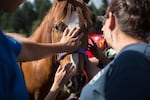
People pet Koda, John Spence's horse, at Wellness Warrior Camp in Grand Ronde, Ore., Wednesday, June 26, 2019.
Bradley W. Parks / OPB
That started to change during the Red Power movement and the occupations of Alcatraz in 1969, the Bureau of Indian Affairs in 1972 and Wounded Knee in 1973. Spence said he followed the lead of activists and began to take a new pride in his identity.
He similarly views the wellness movement in Native communities — and camps like this one — as a new revolution.
Spence (A’aninin-Gros Ventre, Húŋkpapȟa Lakota-Sioux) is a veteran of the Marine Corps and has been sober 36 years. Words like “wellness,” “connection” and “healing” have become central to his life in that time.
“It’s so powerful that we can use them,” he said. “I’m just getting so used to using them.”
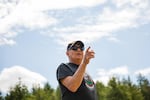
John Spence offers instructions during the connection to horses session at Wellness Warrior Camp in Grand Ronde, Ore., on Wednesday, June 26, 2019.
Bradley W. Parks / OPB
His healing came in part from reestablishing his relationship to horses. Like Spence, his horse, Koda, grew up without parents.
“Traditionally, we used to refer to horses as our children,” Spence said. “... Basically, he’s a son to me and he knows I’m his dad.
“When he sees me, his ears go up and he lets out a whinny. … He doesn’t do that for anyone else. Makes me feel good too, you know?”
At 78, Spence relishes his role in helping Indigenous youth build their own relationships with horses — and with that sense of identity which, for many years, he wasn’t proud of.
Spence put a bridle and saddle on Koda, then helped a boy onto the horse’s back for a short trot around the field.
“I’m so inspired. I love it. I love it,” Spence said. “I wish every kid could have this experience.”
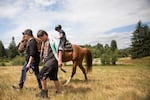
People walk with Koda, John Spence's horse, during the connection to horses session at Wellness Warrior Camp in Grand Ronde, Ore., on Wednesday, June 26, 2019.
Bradley W. Parks / OPB
Words and photos by Bradley W. Parks. Video and portraits by Kaylee Domzalski.
Many of the youth leaders like Kobe Norcross are former campers themselves and/or members of the Indigenous 20 Something Project. Read more about their healing work here.
